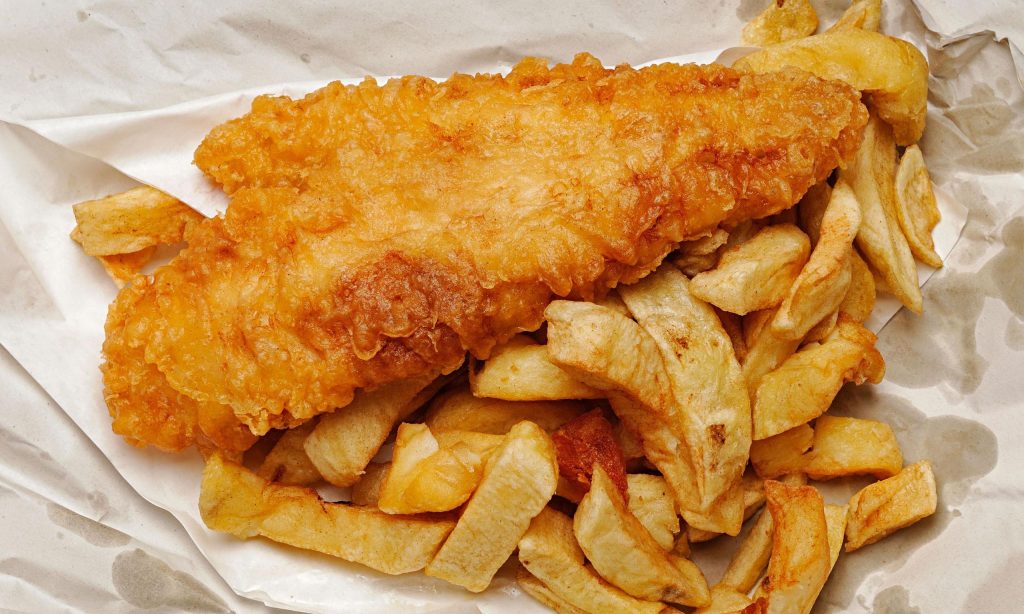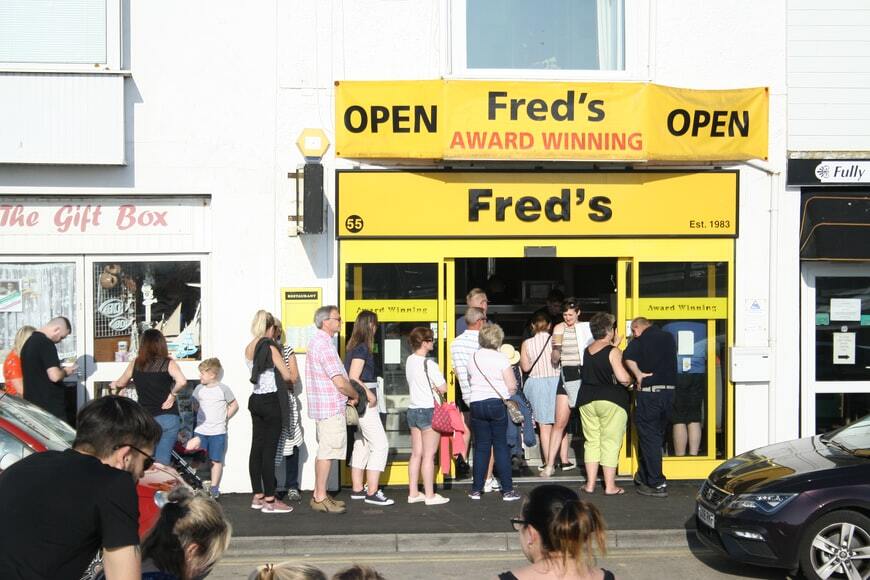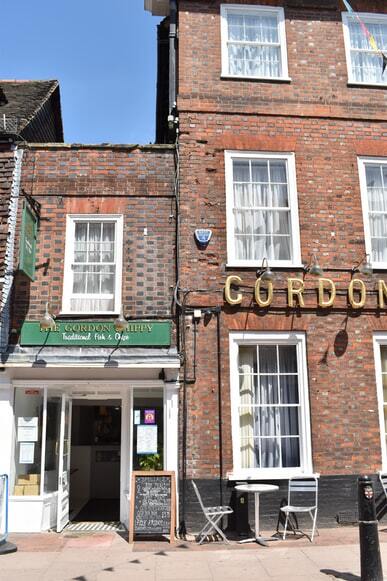Today I’m writing to you from Brighton on the south coast of England. The weather is not that bad actually. A bit of cloud, a bit of sun and the temperature is around 10°. I’m sitting on the beach front and in my hand, I have a little packet of fish and chips.

I got them from a local chippy, Mike, who is a bit of an establishment here and runs one of the best fish & chip places in the country. I have to admit, I was expecting them to be wrapped in yesterday’s newspaper, perhaps with a page 3 girl looking lustfully at me, but, as Mike explained, “health an’ safety put paid to that several years ago.”
Mike’s place is small. There is a table for you to sit at – while you’re waiting. But the strong smell of fat and vinegar doesn’t really make me want to eat there. And why should I when I can sit on the beach? Mind you, the seagulls are a bit of a bother.
Mike’s a cheery sort of bloke. A little on the heavy side, hair receding, but always a smile on his face. “Been in the trade for years”, he says. “It’s a “liddle” different now. Less tourists and lockdown was tough. But things are on the up. Onwards and upwards, as we say here. Got to get on with it. Moaning and moping isn’t going to help. An’, did you know, fish and chips wasn’t rationed during the war?”
He was implying, if this British national dish could make it through the war, (over 70 years ago,) then it could make it through anything. The national dish stands for that typical British resolve not to succumb to anything that isn’t British. Except, it actually originated from Portugal and was introduced by Jews fleeing persecution on the Iberian Peninsula.
“What ya aving, luv?” is the greeting I get when it’s my turn to order my lunch.
So, what exactly I am eating?
“Proper chips for a start”, says Mike, “not them poncy things you ‘ave over on the continent.” A proper chip is that thick potato baton, “abou’ an inch an’ a bit long and half an inch thick. Anything else isn’t a proper chip.” What look like short, fat fingers come in industrial size plastic bags, frozen and are unceremoniously tipped into a large deep fat fryer and left to sizzle.
The choice of fish is not that great. Cod ‘n Chips, Haddock ‘n Chips, Whiting ‘n Chips and a few others. And it’s not cheap either. My lunch will set me back about “a tenner.”
“It’s them quotas” shouts Mike over his shoulder, as he diverts his attention to the chips in the deep fat fryer. Feeling diplomatic, I avoid getting sucked into a discussion about Brexit, fishing rights and so on. And anyway, there is a queue behind me. I don’t want to intrude too much.

In for a penny, in for a pound, I opt for Cod ‘n Chips. “Cod ‘n Chips for the lady”, bellows Mike and I move aside to his wife, Margaret, who is at the till. Cash only. Mike stubbornly sticks to tradition. “I know the world’s going plastic” complains Margaret. “But have you felt them new fivers they introduced a “coupla” years ago? Feel awful, don’t they?”
I’m not sure what to say, so I just smile.
From the corner of my eye, I see Mike taking my cod and dunking it in flour and batter before placing it in a basket and putting it into a second deep fat fryer. It will stay there for about 4 or 5 minutes.
“Hello darlin’ “, says Mike to the next person behind me.
“Ello luv, Could I have a haddock ‘n chips, please” says the middle-aged woman behind me. “You alrigh’ luv? she says, looking over to Margaret.
“Fine,” replies Margaret. “Lovely day, innit?”
Mike checks up on my fish by lifting the basket out of the bubbling fat, but decides it isn’t quite ready yet. It’s funny. This dish, so popular, is prepared with great love and attention, but it doesn’t stand on ceremony. It’s honest, down to earth food, that ‘hits the spot’.
“You just know when you are in the mood for some fish and chips, and then it’s simply the best dish in the world”, somebody explained to me, a few days ago in the pub. “That, in itself, is the best ceremony and respect you can give a meal.”
As I sit here on the beach front, with my fish and chips, (you want “salt n vinegar with those, luv?”) and a pickled onion, given to me as a little present to “foster international friendship”, I taste a chip. It’s got a very slight crunch and then a deliciously, tasty soft centre. And it’s piping hot. I almost burn my tongue. And the fish? Well, despite the calorie laden batter encasing it, it tastes of excellent, almost freshly caught fish. It is beautifully white inside. Delicious, chunky, flaky pieces blend perfectly with the crunchy, rough batter.
The woman behind me in Mike’s shop, sits down a few metres away from me. Lost in our meals, we enjoy a unique moment together, united by a simple dish.

I don’t have my own recipe or take for a traditional fish and chips. It wouldn’t do the dish any justice. Here is one I found on the BBC Good Food website instead.
Enjoy and bon apétit.
Traditional Fish ‘n’ Chips
What you need.
For the batter
- 75g self-raising flour, plus extra for dusting. (Or 75g plain flour with a tsp of baking powder)
- 25g cornflour
- small pinch of ground turmeric
- 125g cold lager or fizzy water
For frying
- about 1 litre sunflower oil
- 2 thick skinless fillets of whiting, ling, pollock, haddock or cod (about 150g each)
For the chips
- 2 large Maris Piper potatoes
- 1 tsp malt vinegar, plus extra to serve
What you do.
STEP 1
Cut the potatoes into chips and soak in cold water for 5 mins, then wash until the water runs clear. Tip into a pan of cold water with a pinch of salt and 1 tsp vinegar. Bring to a simmer, then turn down the heat and simmer gently for 10-12 mins until cooked through but not falling apart. Drain gently, then place on a tray in a single layer and chill until needed. Can be prepared a day ahead.
STEP 2
When you’re ready to fry, prepare the batter. Tip the flours and turmeric into a bowl with a pinch of salt, pour over the beer or fizzy water, and mix quickly until everything just comes together to the consistency of double cream – do not over-beat, a few lumps are fine. Keep chilled.
STEP 3
Pour the oil into a deep, wide pan like a wok, or heat a deep-fat fryer to 180C. If using a pan or wok, ensure that it is no more than two-thirds full with oil. Heat the oil until it is shimmering and carefully lower in the chips using a slotted spoon. Fry for 8-10 mins, gently stirring occasionally until golden and crisp. Transfer to kitchen paper to drain.
STEP 4
Put a little flour in a dish, then bring the oil you used to cook the chips up to 185 °C if you have a thermometer, or until a drizzle of batter sizzles and crisps in less than a minute. Working quickly, dust the fish in flour, then dredge through the batter. Hold the fillet above the batter to let the excess drip back into the bowl, then carefully lower into the oil. Fry the fillets for a minute until the batter is just starting to set, then take a spoon and drizzle the fillets with extra batter to create an even crunchier, crispy coating. Fry the fish for about 4 mins, turning once, until deep golden and crisp. Lift onto some kitchen paper to drain for a minute, then serve with the chips and plenty of salt and vinegar.